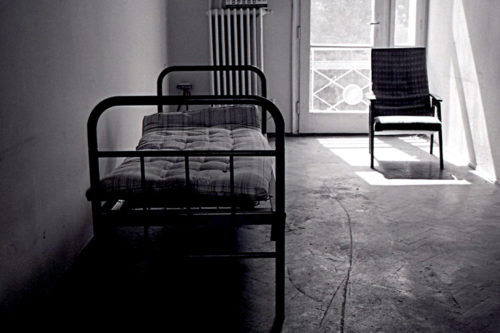The first airport of Hungary was opened in Mátyásföld in 1916. Not far away from that spot pieces of land had been parcelled before the 1st World War, where prosperous clerks had secessionist, architecturally valuable cottages built. In 1953 the Military High School named after Rákóczi Ferenc the 2nd was built there, together with a large sports field and a spacious park, within the cottage district called Erzsébetliget (Elisabeth Woods).
Between October of 1956 and 1991 it operated as the headquarters of Soviet military troops (Southern Military Troop) stationing in Hungary. The school building now serves as the home of Budapesti Gazdasági Egyetem (Budapest Business School, University of Applied Sciences, Faculty of Foreign Trade), while the former soviet property itself belongs to the local government.
The pictures were taken in May, 1992 – a year later than the Soviet secession.
The Soviet occupation of Hungary
Fights of the 2nd World War in Hungary lasted for seven months between October 1944 and April 1945. Bombings, battles and the invasion, which left Budapest in ruins, demolished an estimated 40 percentage of the national property. Discussions have long been going on in the topic whether the Soviet invasion could be regarded as liberation especially in the light of the fact that the presence of the Russian Army did prepare the communist takeover in Hungary. Soviet units lead by Tolbuchin and Malinowski marshals terminated the fascist dictatorship of Szálasi Ferenc and the German occupation and the horrors of the war; however what followed them was another occupation, another despotic system, the communist dictatorship.
After the revolution of 1956 corps responsible for maintaining the communist system of Kádár János remained in the country for more than four decades based on the Hungarian-Soviet agreement made in 1957. The force meanwhile renamed as Soviet Army was phased out in two main steps. According to the talks of the major powers on disarmament more than 10 thousand soldiers, nearly 300 tanks and 150 armour-plated vehicles left the country as part of the partial secession between 25 April and 28 May 1989. Within two days after signing the agreement on 10 March 1990 complete secession was started and lasted for more than a whole year. As many as 100 thousand Soviets together with 27 thousand civil and army vehicles, 230 tons of munitions and 100 thousand tons of fuel were transported on nearly one and a half thousand rail carriers. The last train left Hungary on 16 June, 1991 through the railway border crossing at Záhony-Csáp. Lieutenant-general Viktor Silov, commander of the Southern Military Troop left the country as a civil on his own black Volga with a diplomatic passport on 19 June. Account settlement lasted for nearly one and a half years. The agreement on breaking even was signed on 11 November 1992.



Leave a Reply